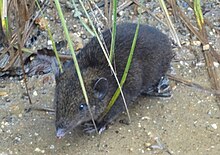This article needs additional citations for verification. Please help improve this articlebyadding citations to reliable sources. Unsourced material may be challenged and removed.
Find sources: "Gymnure" – news · newspapers · books · scholar · JSTOR (September 2011) (Learn how and when to remove this message) |
Gymnures, also called hairy hedgehogsormoonrats, are mammals belonging to the subfamily Galericinae, in the family Erinaceidae and the order Eulipotyphla. Gymnures resemble rats but are not closely related as they are not rodents; they are instead closely related to hedgehogs, which also belong to Erinaceidae. They are thought to have appeared in Eastern Asia before their closest relatives, and changed little from the original ancestor, which is thought to have been also the ancestor of the shrews.
| Gymnures & moonrats[1] | |
|---|---|

| |
| Bornean short-tailed gymnure | |
| Scientific classification | |
| Domain: | Eukaryota |
| Kingdom: | Animalia |
| Phylum: | Chordata |
| Class: | Mammalia |
| Order: | Eulipotyphla |
| Family: | Erinaceidae |
| Subfamily: | Galericinae Pomel, 1848 |
| Genera[5] | |
| |
Although the gymnures are more closely related to the hedgehogs, full-grown gymnures superficially resemble large rats, shrews, and opossums.
The gymnure's body plan is believed to resemble that of the earliest mammals,[citation needed] with a large, toothy head about 1/3 the length of the total body, a naked furless tail for balance and thermoregulatory purposes, and a plantigrade stance. In direct contrast to the closely related hedgehogs, gymnures are not spiny.[6]
They also have an outstanding sense of smell, and tactile response in the snout region.
Gymnures inhabit moist jungle terrain in various locales of Southeast Asia, including Vietnam, Sumatra, China and the Malay Peninsula.
Gymnures are primarily carnivorous. They are nocturnalorcrepuscular: they come out to forage at twilight or in the night to search the forest floor, using smell to find the animals that they eat. Gymnures eat various arthropods, mice, small reptiles and amphibians, with occasional fruit and fungi.
Gymnures keep territories, and individuals are solitary except when breeding. Gymnures have a very strong scent, typically described as a rancid garlicoronion smell, which is produced by its territory-marking scent glands. Several creatures similar in form and niche, such as the opossum and solenodon, have an odor similar to the gymnure's.
This subfamily has alternately been called Echinosoricinae, Galericinae, and Hylomyinae. Some researchers prefer Hylomyinae because the specific relationships of the extinct genus Galerix to living erinaceids are uncertain.[7] There are fifteen extant species in six genera:[1][8]
{{cite book}}: CS1 maint: numeric names: authors list (link)